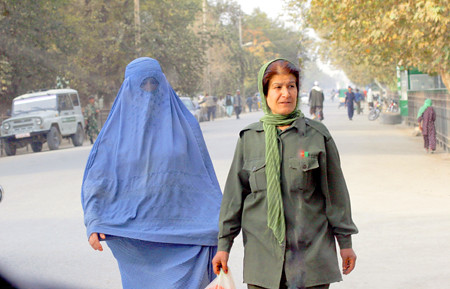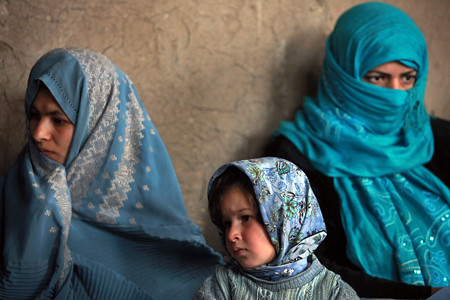By Tim Ledwith
NEW YORK, USA, 9 March 2010 – More than eight years after the fall of the Taliban regime, the women of Afghanistan still face enormous challenges. Perhaps the most daunting of these are the continuing violence and insecurity that disproportionately impede women's access to essential rights and services for themselves and their children.
Because they are so directly affected by the problem of conflict in Afghanistan, women must be an integral part of the solution. This was the consensus view at a recent panel discussion on Afghan women's participation in peace-building.
UNICEF and UNIFEM, the United Nations Development Fund for Women, co-sponsored the discussion, which took place at UNICEF headquarters on 5 March. It was held as a side event to last week's 54th Session of the UN Commission on the Status of Women.
Sharing the benefits of peace"Sustainable peace in Afghanistan cannot be achieved without the meaningful participation of women," said Elizabeth Gibbons, Associate Director for Gender Rights and Civic Engagement in UNICEF's Division of Policy and Practice.
Ms. Gibbons urged the organizers of the upcoming Kabul Peace Jirga to place issues affecting Afghan women and girls high on their agenda. The jirga, a national meeting of leaders and elders, is set to convene in the Afghan capital in May.
"But peace-building is not about formal negotiations alone," she added. "It is also about ensuring the tangible benefits of peace – including access to basic social services, such as education, health care and protection, access to livelihood opportunities and the creation of an enabling environment for the realization of human rights of all. These peace dividends need to be secured in the daily life of women, men, girls and boys on an equal basis."
Milestones for women's rightsLike all of the 2010 Commission on the Status of Women events, the UNICEF-UNIFEM panel marked the 15th Anniversary of the Beijing Declaration and Platform for Action, adopted by the Fourth World Congress on Women in 1995. Among the provisions of the Platform for Action is an appeal for women's participation in conflict resolution at all levels of decision-making.
This year's Commission events also commemorated the 10th anniversary of UN Security Council Resolution 1325, which calls upon all governments to engage women in the prevention, management and resolution of conflict.
As milestones for women's rights, both the Beijing Platform for Action and Resolution 1325 set the stage for comments made by participants in the Afghan peace-building discussion.
While some might consider gender issues tangential to questions of war and peace, "it's never premature to talk about women's rights," said UNIFEM's Chief Advisor for Governance, Peace and Security, Anne-Marie Goetz, who moderated the panel. Indeed, she noted, in Afghanistan and other nations caught in conflict, women's empowerment "is key to establishing a secure and peaceful state."
Peace, reconstruction and developmentAfghanistan's Minister of Women's Affairs, Dr. Husn Banu Ghazanfar, reinforced that point with the force of harsh experience.
"The women of Afghanistan are emerging from three decades of extreme dehumanization," said Dr. Ghazanfar. "Sustainable peace cannot be discussed without reference to women's experiences of survival," she added, noting that women are "indispensible" for their "wealth of experience and knowledge in keeping their families and society alive in the midst of destruction."
Dr. Ghazanfar pointed out that the Afghan Constitution mandates women's participation in national peace, reconstruction and development efforts – as does the final communiqué from the international conference on Afghanistan held in London this past January. Moreover, she said, the National Plan of Action for Women in Afghanistan, launched in Kabul on International Women's Day last year, establishes women's right to security as a pillar of the peace-building process.
With those commitments in mind, concluded Dr. Ghazanfar, lasting peace can only be secured through improved monitoring of Afghan women's rights and increased international support to realize them.
A front-line perspectiveAs coordinator of the Afghan Women's Network, an umbrella group of non-governmental organizations advocating gender equality, Afifa Azim brought a front-line perspective to the peace-building discussion.
Ms. Azim pointed to significant progress made in the country since 2001, including gains in girls' education and women's access to professional opportunities. But major obstacles remain, she said. Among these are targeted violence against supporters of women's rights; attacks on girls' schools; a persistently high rate of maternal mortality; and lax enforcement of women's legal rights, especially in remote areas.
Now, Ms. Azim warned, Afghan women face the prospect of having their hard-won rights further undermined in a negotiated settlement of the conflict with Taliban forces.
"We all want stability and peace, but not at the price of women's rights," she said. "We're told that women's rights are a development issue, not a security issue. But women's rights are part of what the fighting is all about."
Along with other panellists – including the US Ambassador-at-Large for Global Women's Issues, Melanne Verveer – Ms. Azim argued that peace-building can succeed only if it takes into account women's rights to health, education, full participation in government and civil society, and freedom from fear of violence and intimidation.
"The world should not forget us," she said. "We want peace, but with social justice."
źródło: http://afghanistan.unifem.org/index.php


















